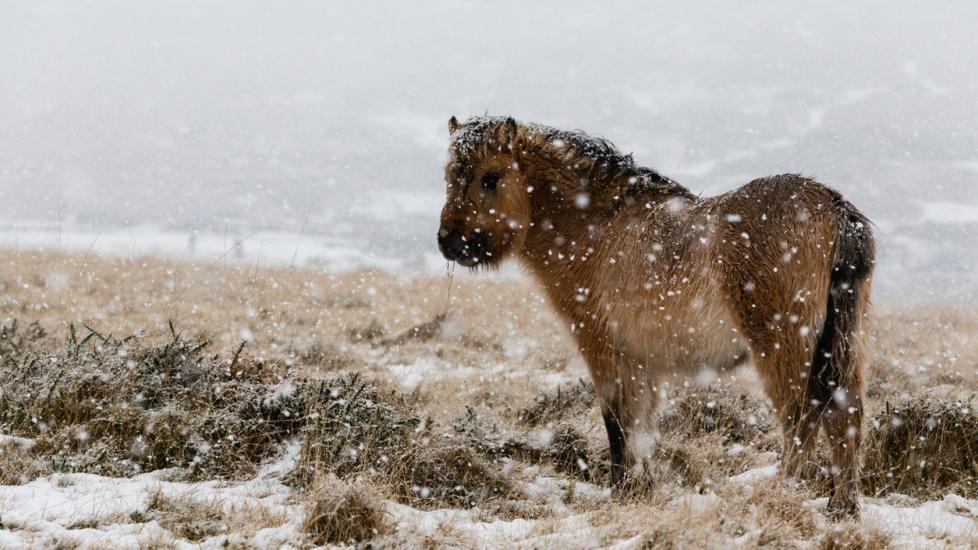Dartmoor Pony
Reviewed for accuracy October 5, 2022.
The Dartmoor is a small, hardy pony which probably originated in the now protected national park area of Dartmoor in England. Standing between 11.1 to 12.2 hands tall (or 44.4 to 48.8 inches in height), the Dartmoor Pony is a gentle creature that is useful in assisting beginner riders overcome their fear of riding and jumping. Dartmoor ponies with recorded bloodlines are considered rare due to the drastic drop in population several decades ago.
Physical Characteristics
The Dartmoor Pony has a small, well-defined body type—muscular but not overly chunky; however, because it is a pony, this breed is inherently an “easy keeper” and can gain weight on little grain. Both its head and ears are rather small; the pony's neck, meanwhile, is of average length. The Dartmoor Pony's shoulders slope down to its muscular quarters, which lead to its brawny legs and tough hooves. Its full tail is set quite high.
The Dartmoor Pony appears in various colors, including bay, brown, black, and sometimes chestnut. Even rarer is a Dartmoor Pony with a roan coat. White markings on the pony's coat, although allowed, are still very much discouraged in standard breeding practices.
Personality and Temperament
The Dartmoor Pony is a very gentle, strong, and willing breed. This makes it an ideal mount for children, especially those who are just beginning to learn how to ride.
History and Background
Although the origin of the Dartmoor Pony remains a mystery, the earliest reference of the breed occurred in 1012, when Bishop Aelfwold of Crediton listed a Dartmoor Pony in his will. Between the 12th and 15th centuries, the ponies were used mainly to carry tin off the moor to the tannery towns. However, when the tin mining boom came to an end, so did the pony's duties. Those left were either set free to roam the moor or sent to work on farms.
In 1893, the National Pony Society (sometimes referred to as the Polo Pony Society) was formed. By 1899, sections opened in the The Polo Pony Stud Book accepting registered Dartmoors. As with many other animals, the devastation of World War I in the early 20th century caused the number of Dartmoor Ponies to dwindle. Fortunately, the Duchy Stud, an organization owned by the Prince of Wales, bought many Dartmoor Ponies, and bred them with other horses in a concerted effort to revive the breed and perfect a saddle horse. Dwarka, an Arab stallion, was used in one such breeding program. The efforts involving Dwarka turned out to be quite successful; his broodmares gave birth to the notable horses, Leat and Hetherbelle VI.
The destruction brought on by World War II in the mid-20th century again diminished the number of Dartmoor Ponies and nearly led to the breed's extinction. As such, all Dartmoor Ponies that won prizes in horse show competitions were automatically admitted into the register in order to revive the breed's numbers once again.
In 1988, the Dartmoor Pony Moorland Scheme was established by the Duchy of Cornwall and the Dartmoor Pony Society. The organization sought to halt the decline in the number of Dartmoor Ponies by encouraging the breeding of purebred Dartmoors and introducing a new gene pool to the registered ponies. According to the Dartmoor National Park Authority, there are fewer than 2,000 ponies found today, from approximately 30,000 in 1950. Its success is still undetermined, yet the Dartmoor Pony's rare breed status further illustrates the need for such an organization.
Curiously, a record describing the Dartmoor Pony in 1298 by the Polo Pony Society is nearly identical to the modern-day Dartmoor Pony. Therefore, it can be safely assumed that the breed has not changed its appearance much over the centuries—even with its troubled history.
Care and Health
Because Dartmoor Ponies are easy keepers, they can easily become overweight if fed too much hay or grain. This can lead to potential development of equine metabolic syndrome (EMS), or pars pituitary intermedia dysfunction (PPID) otherwise known as Cushing's Disease.
Featured Image: iStock.com/Hal Gamble
